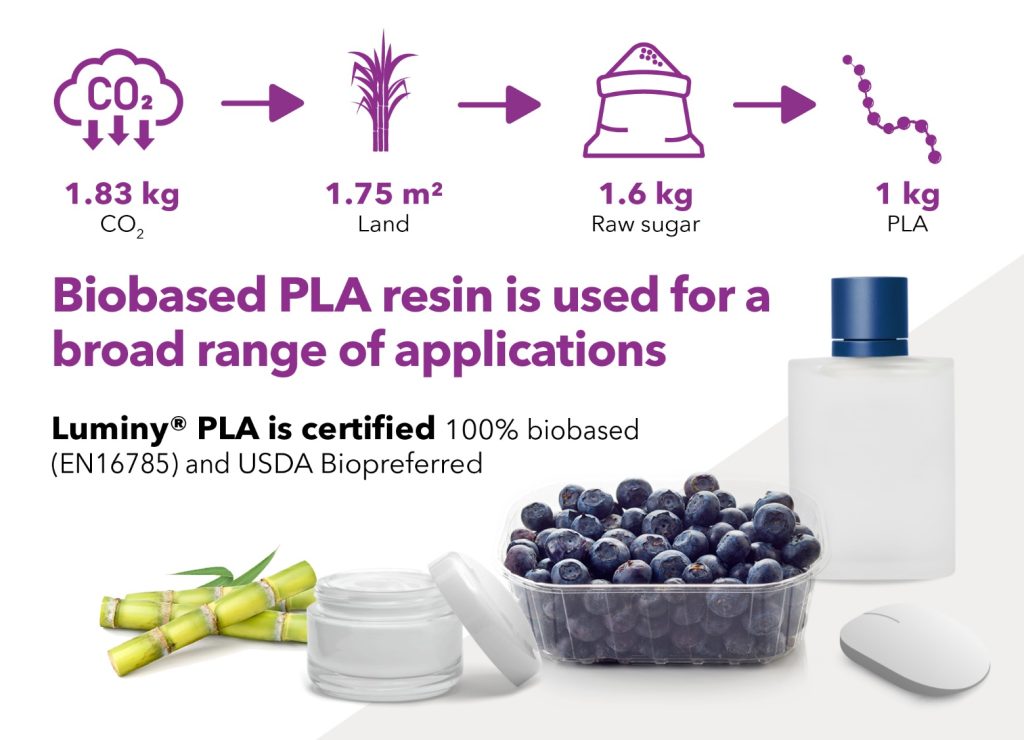Netherlands based sustainable Polylactic Acid (PLA) manufacturer TotalEnergies Corbion has announced that its Luminy PLA bioplastics meet the European Union (EU) Taxonomy Regulation on climate change mitigation and adaptation.
The EU Taxonomy Regulation determines what can be labeled as “sustainable” by businesses in the EU. The framework uses six key environmental objectives to assess this: climate change mitigation, climate change adaptation, sustainable use and control, and protection and restoration of biodiversity and ecosystems. The regulation aims to increase sustainable investment, and drive the implementation of the European Green Deal.
TotalEnergies Corbion’s recent assessment has been published in a whitepaper titled “Planting the Future with PLA.” The company claims that this achievement underscores their significant role within the global sustainable economy.
“TotalEnergies Corbion continues to work closely with lawmakers, regulators, and non-governmental organizations as we push to create more sustainable plastic alternatives. In addition to compliance with the EU Taxonomy Regulation, our entire line of Luminy® PLA is certified 100% biobased according to EN16785 and the USDA biopreferred program,” commented Maelenn Ravard, TotalEnergies Corbion’s Sustainability and Regulatory Manager.
“What’s more, our production plant is ISO certified for environmental management, quality, and safety and we follow the regulations set by the World Wildlife Fund’s sugarcane industry organization Bonsucro. We are proud to set this standard for the bioplastics industry moving forward.”

Luminy PLA, sustainable bioplastics
Luminy PLA bioplastics are 100% biobased and biodegradable, being entirely produced using sugar cane. Sugar cane is an annually renewable crop which, unlike trees, can be replanted on the same land once it has been harvested.
According to the whitepaper, Luminy PLA production requires 1.75㎡ of sugarcane farmland per kilogram of PLA. This captures 1.8kg of CO2 from the atmosphere as it grows. Moreover, TotalEnergies Corbion produces their PLA in Thailand, using just 0.08% of the country’s arable land. The company claims that this combination of land efficiency and carbon capture makes their PLA bioplastics an ideal option for reducing reliance on fossil-based plastics.
The company claims that the production of biobased Luminy PLA has a 75% reduced carbon footprint, compared to conventional plastics.
Additionally, since 2021 TotalEnergies Corbion has offered Luminy rPLA, a recycled version of Luminy PLA. Advertised as the world’s first commercially available chemically recycled bioplastics product, rPLA is said to offer the same quality as virgin PLA. This is thanks to the recycling process, which depolymerizes post-industrial and post-consumer PLA waste via hydrolysis, producing lactic acid. The lactic acid is then reprocessed into the polymerization line to produce new PLA.
During the lifecycle of a standard PLA product, CO2 is absorbed, stored, and eventually released back into the atmosphere. However, when recycling PLA, the biogenic carbon is kept in the cycle, and transferred to a new PLA item. This locks in the CO2 for longer, reducing the environmental impact.
TotalEnergies Corbion’s estimates indicate a reduction of 320 kg, CO2eq/ton of PLA for a Luminy PLA with 30% recycled content, compared to virgin PLA.

TotalEnergies Corbion PLA applications
TotalEnergies Corbion supplies their PLA to filament producers within the FDM field, who then convert the PLA into spools. The spools are generally sold to hobbyists, and customers who produce manufacturing tools in the automotive industry. Education, art and design, indoor furniture and decoration articles are also common use cases.
The company also has direct customers within the pellet additive manufacturing sector. These PLA pellets are generally used in large format 3D printing applications, such as building and construction, furniture, art and design and museum exhibitions.
One specific customer is Wyve, a 3D printed surfboard manufacturer. Wyve uses Luminy LX175 core bio-based material to 3D print low-weight surfboards with high strength and stiffness.
TotalEnergies Corbion has also collaborated with Netherlands-based 3D printing materials company colorFabb to produce light-weight, heat-resistant Luminy PLA filaments. This material is aimed towards 3D printing remote control airplanes, which have a reduced density and can withstand the sun’s heat while in flight.

3D printing and sustainability
Increasing sustainability is certainly a key focus within additive manufacturing at the minute, with a number of companies producing and employing recycled materials.
Earlier this year KIMYA, additive manufacturing materials subsidiary of French printing and coating firm ARMOR, published a Life Cycle Analysis for its PETG filaments. This LCA indicated that KIMYA’s recycled PETG helps to reduce CO2 emissions by up to 35%, compared to their non-recycled counterparts.
Benoît Stoeux, Managing Director at KIMYA, claimed that this LCA was born out of the company’s missions to encourage companies to reduce their carbon footprint, and “choose more environmentally friendly alternatives.”
Elsewhere, it was recently announced that IperionX will supply Ford with 100% recycled low-carbon titanium. This partnership forms part of Ford’s ongoing mission to reduce its carbon footprint, and achieve carbon neutrality by 2050.
Subscribe to the 3D Printing Industry newsletter to ensure you keep up with the latest 3D printing news. You can also follow us on Twitter, like our Facebook page, and subscribe to the 3D Printing Industry Youtube channel to access more exclusive content.
Are you interested in working in the additive manufacturing industry? Visit 3D Printing Jobs to view a selection of available roles and kickstart your career.
Featured image shows a Luminy PLA information poster. Image via TotalEnergies Corbion.


